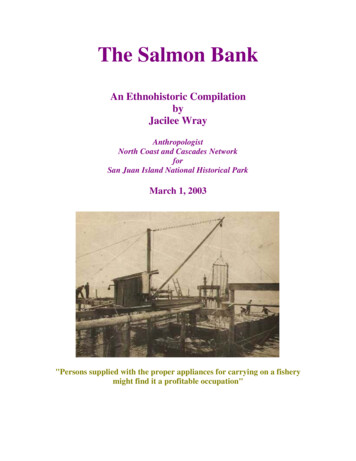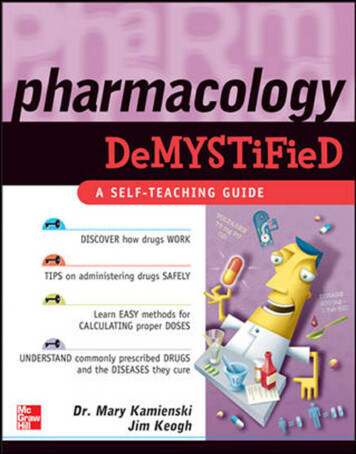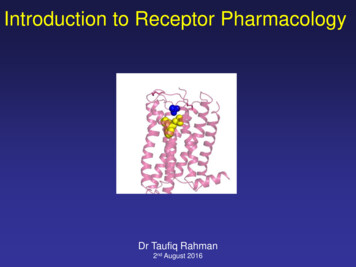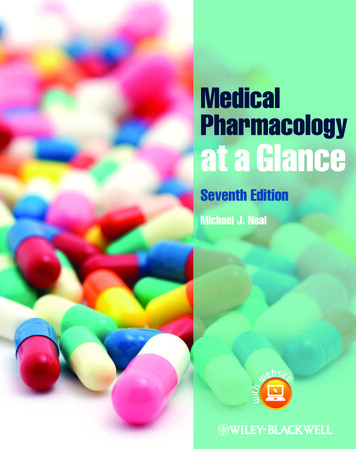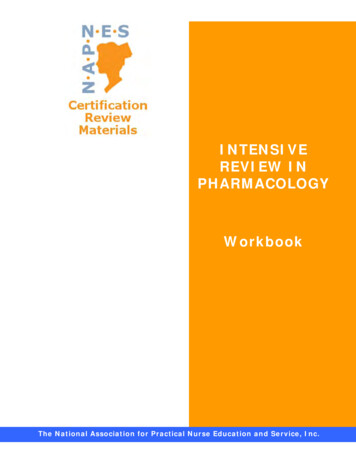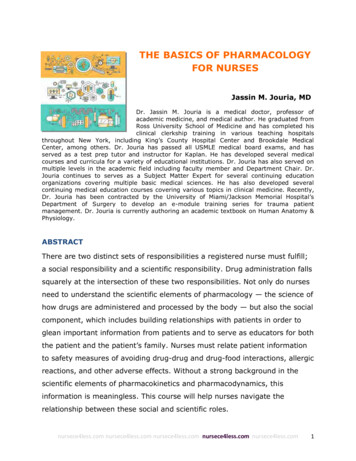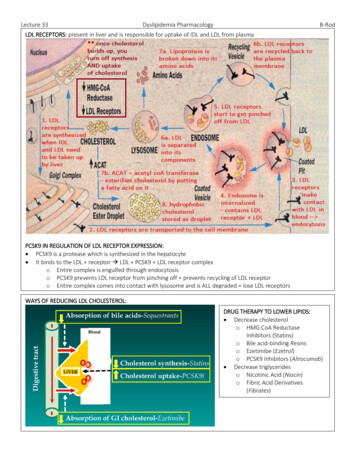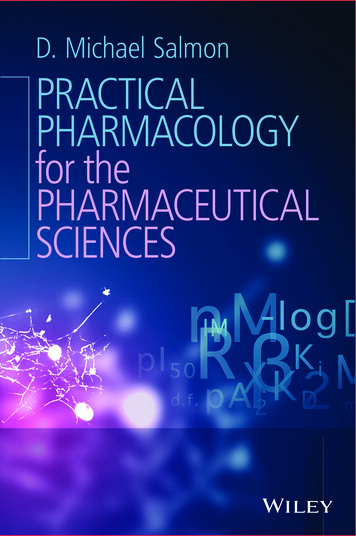
Transcription
D. Michael SalmonPRACTICALPHARMACOLOGYfor thePHARMACEUTICALSCIENCES
Practical Pharmacology for thePharmaceutical Sciences
Practical Pharmacology forthe Pharmaceutical SciencesD. Michael SalmonSchool of Health and Biosciences, University of East London, UK
This edition first published 2014 C 2014 John Wiley & Sons, LtdRegistered officeJohn Wiley & Sons Ltd, The Atrium, Southern Gate, Chichester, West Sussex, PO19 8SQ,United KingdomFor details of our global editorial offices, for customer services and for information about how toapply for permission to reuse the copyright material in this book please see our website atwww.wiley.com.The right of the author to be identified as the author of this work has been asserted in accordancewith the Copyright, Designs and Patents Act 1988.All rights reserved. No part of this publication may be reproduced, stored in a retrieval system, ortransmitted, in any form or by any means, electronic, mechanical, photocopying, recording orotherwise, except as permitted by the UK Copyright, Designs and Patents Act 1988, without theprior permission of the publisher.Wiley also publishes its books in a variety of electronic formats. Some content that appears in printmay not be available in electronic books.Designations used by companies to distinguish their products are often claimed as trademarks. Allbrand names and product names used in this book are trade names, service marks, trademarks orregistered trademarks of their respective owners. The publisher is not associated with any productor vendor mentioned in this book.Limit of Liability/Disclaimer of Warranty: While the publisher and author have used their bestefforts in preparing this book, they make no representations or warranties with respect to theaccuracy or completeness of the contents of this book and specifically disclaim any impliedwarranties of merchantability or fitness for a particular purpose. It is sold on the understanding thatthe publisher is not engaged in rendering professional services and neither the publisher nor theauthor shall be liable for damages arising herefrom. If professional advice or other expert assistanceis required, the services of a competent professional should be sought.The advice and strategies contained herein may not be suitable for every situation. In view ofongoing research, equipment modifications, changes in governmental regulations, and the constantflow of information relating to the use of experimental reagents, equipment, and devices, the readeris urged to review and evaluate the information provided in the package insert or instructions foreach chemical, piece of equipment, reagent, or device for, among other things, any changes in theinstructions or indication of usage and for added warnings and precautions. The fact that anorganization or Website is referred to in this work as a citation and/or a potential source of furtherinformation does not mean that the author or the publisher endorses the information theorganization or Website may provide or recommendations it may make. Further, readers should beaware that Internet Websites listed in this work may have changed or disappeared between whenthis work was written and when it is read. No warranty may be created or extended by anypromotional statements for this work. Neither the publisher nor the author shall be liable for anydamages arising herefrom.Library of Congress Cataloging-in-Publication DataSalmon, Michael (D. Michael), author.Practical pharmacology for the pharmaceutical sciences / Dr. Michael Salmon.p. ; cm.Includes bibliographical references and index.ISBN 978-1-119-97550-2 (pbk.)I. Title.[DNLM: 1. Pharmacology–Laboratory Manuals. 2. Chemistry, Pharmaceutical–LaboratoryManuals. 3. Pharmaceutical Preparations–Laboratory Manuals. QV 25]RM301.25615.1078–dc232013037819A catalogue record for this book is available from the British Library.ISBN: 9781119975502Set in 10.5/13pt Sabon by Aptara Inc., New Delhi, India12014
ContentsPrefaceixAcknowledgementsxi1 Before Entering the Pharmacology Laboratory1.1 Safety and Risk Assessment1.2 The Laboratory Record Book1.3 Use of Animals in Practical Pharmacology1.4 Experimental Design1.5 Units, Dilutions and Logarithms1.5.1 Units of Mass1.5.2 Units, Concentrations and Logarithms1.5.3 Dilutions1.5.4 Logarithms1.6 Essential Statistics1.6.1 Continuous Data – t-test, ANOVA,Non-parametric Tests and Regression1.6.2 Discontinuous Data – 2 and Fisher’s Exact TestReferences11345788910121221252 Basic Pharmacological Principles2.1 Drug–Receptor Interaction2.1.1 Agonists2.1.2 Antagonists2.1.3 Receptor Classification2.2 Bioassays2.2.1 Single-point Assays27272730363738
viCONTENTS2.2.22.2.3Bracketing Assays, Three-point or 2 1 AssaysMulti-point Assays, Such As Four-point or2 2 AssaysReferences3839403 Isolated Tissues and Organs3.1 Equipment for In Vitro Experiments3.2 Organ Baths3.3 Physiological Salt Solutions3.4 Transducers3.5 Recording Equipment and Software3.6 Dosing3.7 Electrically Stimulated Preparations3.8 Fault-Finding of In Vitro Isolated Tissue PreparationsReferences434445464749505253544 Smooth Muscle Preparations4.1 Gastrointestinal Smooth Muscle Preparations4.2 Guinea Pig Isolated Ileum4.2.1 Concentration–Response Curvesfor Cholinesters4.2.2 Selective Antagonism4.2.3 Specificity of Blood Cholinesterases4.2.4 Quantification of the Potency of an Antagonist4.2.5 Bioassays4.2.6 Calcium Channel Blockers4.2.7 Field-stimulated Guinea Pig Isolated Ileum4.3 Rabbit Isolated Jejunum and the Finkleman Preparation4.3.1 Adrenoceptor Sub-types4.4 Isolated Tracheal Rings4.5 Isolated Vas DeferensQuestions on Isolated Tissue PreparationsAnswers to 925 Cardiovascular Preparations5.1 Isolated Perfused Heart Preparations5.1.1 The Langendorff Preparation5.1.2 Cardiac Interactions of Anti-asthma Drugs5.1.3 The Rat Isolated Auricle Preparation9394959899
CONTENTS5.2 Thoracic Aorta Preparation5.2.1 Drugs Regulating Nitric Oxide-mediatedRelaxationReferences6 Skeletal Muscle6.1 Types of Skeletal Muscle6.2 Multiply-Innervated Skeletal Muscle Preparations6.2.1 Agonists and Antagonists Acting on the FrogRectus Abdominis6.2.2 Action of Anticholinesterases on the DorsalMuscle of the Leech6.3 Focally Innervated Skeletal Muscle Preparations6.3.1 The Frog Gastrocnemius Muscle–SciaticNerve 61191207 Isolated Cells7.1 Freshly Isolated and Cultured Cells7.1.1 Advantages of Isolated Cells7.1.2 Cultured Cells7.1.3 Cell Counting7.2 Platelets7.2.1 Inhibition of Aggregation by Nitric OxideDonors7.3 Neutrophils7.3.1 Measurement of NADPH Cytochrome cReductase7.3.2 Measurement of Intracellular [Ca2 ]References1211211211221221258 Biochemical Pharmacology8.1 Pharmacological Applications of Common BiochemicalTechniques8.2 Enzyme Inhibitors8.3 Acetylcholinesterase Inhibitors8.4 Monoamine Oxidase Inhibitors8.4.1 Sub-cellular Distribution of MAO Activity8.4.2 Specificity of MAO Inhibitors for Isoenzymes8.5 Thrombin Inhibitors8.6 ATPase 146149151155158
viii9 Complementary Methods for Teaching PracticalPharmacology9.1The Comparative Merits of Available Methods9.2Interpretation of Experimental Data9.2.1 Behavioural Experiments9.2.2 Analysis of Metabolites of5-hydroxytryptamine9.2.3 Radioligand BindingAnswers to 610 Communicating Results10.1 Preliminary Reports10.1.1 Tables10.1.2 Graphs10.1.3 Bar Graphs10.1.4 Preliminary Conclusions10.2 Poster Presentations10.3 Oral Presentations10.4 Project Reports10.5 Pharmacological Literature10.6 How to Cite Scientific Information Sources10.7 187188188Appendix 1: Molecular Weights of Commonly Used Drugs189Appendix 2: Useful Resources for Practical Pharmacology191Index193
PrefaceIt is a startling fact that it is 30 years since the last text book on pharmacology laboratory practicals (Kitchen, 1984) was published. An obvious assumption would be that there has been a drastic fall in demand.A common response is that laboratory practicals are redundant andhave been replaced by computer-assisted learning (CAL) and simulatedexperiments (Hughes, 2003). This is due to the challenges of increasingstudent numbers, decline in staff numbers and the high cost of maintaining laboratories and animal facilities (Hughes, 2001). It has beenclaimed that CAL experiments and problem-based learning provide anequal or superior student learning experience (Hughes, 2001, 2002).Yet surveys of the curriculum of pharmacology courses in the UnitedKingdom (Dewhurst and Page, 1998), and currently using a world-wideInternet survey, quickly reveals that this is not the case. “Wet” laboratory practicals remain a central part of most courses, and clearly manyuniversities and colleges are reluctant to abandon them completely, asemployers in the pharmaceutical industry and academia expect handson experience of pharmacological techniques. In the United Kingdom,the British Pharmacology Society (www.bps.ac.uk/Education/Universityresources/Core curricula in pharmacology, (accessed June 2013)) currently recommends an undergraduate pharmacology core curriculum inwhich skills in pharmacological experimentation form an essential component (see www.bps.ac.uk/education/university resources/core curricula). Most courses now appear to rely on in-house schedules of variablequality. Meanwhile, the equipment available for the pharmacology laboratory has greatly improved mainly through the use of computers tocontrol experiments and record data, which makes them easier to useand improve the quality of data obtained by novice students. It is a fearthat some of the skills involved in real, wet experimentation may be lost
xPREFACEas new lecturers themselves have not been taught these methods. It istherefore timely to produce a book for use in pharmacology practicalclasses using state-of-the-art equipment and using modern nomenclature. Several books have recently described laboratory techniques andcalculations for the biosciences in general. In contrast, this book specifically aims to introduce practical pharmacology to the pharmaceuticalsciences undergraduate student.The book opens with an outline of how to prepare to work in the pharmacology laboratory, and progresses to briefly describe some of the basicprinciples of pharmacology, which I believe are most clearly understoodfrom a historical perspective. The central core includes experiments usingin vitro tissues, isolated cells and cell-free biochemical systems, focusingon those that are unique to pharmacology. Some of these are classicalexperiments which were introduced some years ago, and form the basisof the discipline of pharmacology. However, it is important to note thatthey are still topical in that they are still being interpreted in new waysin the light of current research. Several techniques included in the BPScore curriculum, such as molecular biology, biochemistry, electrophysiology and tissue culture widely used in pharmacological research areonly alluded to, as these have been well covered elsewhere. In conclusion, since no experiment is complete without communicating the results,there is a section on the presentation and interpretation of results andhow to use and cite information sources. This book aspires to be usefulfor students in all pharmaceutical science courses that include pharmacology modules giving a real life experience in learning pharmacology.Powerpoint slides to accompany this book can be downloaded fromhttp://booksupport.wiley.com by entering the book name, author or isbninformation.REFERENCESDewhurst, D.G. and Page, C.P. (1998) A survey of the content of B.Sc. courses in Pharmacology in UK universities – is it time for a core curriculum? Trends Pharmacol. Sci.19: 262–265.Hughes, I.E. (2001) Do computer simulations of laboratory practicals meet learningneeds? Trends Pharmacol. Sci. 22: 71–74.Hughes, I.E. (2002) Simulations – as much learning as with wet practicals? in TeachingPharmacology Tomorrow: Tools and Techniques.Hughes, I.E. (2003) Teaching pharmacology in 2010–new knowledge, new tools, newattitudes. Folia. Pharmacol JPN 122: 411–418. doi:10.1254/fpj.122.41Kitchen, I. (1984) Textbook of In Vitro Practical Pharmacology, Blackwell ScientificPublications. ISBN 0-632-01216-1.
AcknowledgementsI am indebted to many colleagues at the University of East London withwhom I worked for many years. Without their experience and fortitudethis book would not have been written. I am especially indebted to myfellow lecturers, Barry Jones, Alun Morrinan, Wilson Steele, Pat Freemanand Gill Sturman. I also received unstinting technical support from NickSeeley and Kevin Clough. Finally, I must take the blame for any errorsin this book that have been overlooked, and would be most grateful ifthey are brought to my attention.
1Before Entering thePharmacology LaboratoryBefore embarking on any new activity, it is wise to be familiar withthe language, concepts and possible risks of the venture. So this bookbegins with a number of topics with which an experimenter must befamiliar, such as health and safety, ethical and legal considerations andfundamental principles of experimental pharmacology. No experimenthas much value unless a coherent design has been devised first. Thedesign of an experiment is crucial if it is to yield meaningful results.Having obtained the experimental data, it is important to decide onthe relevant statistical methods that will be employed to evaluate theresults. Obvious as this may seem, it is shocking, even in professionalresearch, how many experiments are wasted due to a lack of planningin design.1.1 SAFETY AND RISK ASSESSMENTAll activities which involve the use of chemicals, from the factory floor tothe research laboratory, are subject to the Health and Safety legislation.In the United Kingdom, this is don
therefore timely to produce a book for use in pharmacology practical classes using state-of-the-art equipment and using modern nomencla-ture. Several books have recently described laboratory techniques and calculations for the biosciences in general. In contrast, this book specif-ically aims to introduce practical pharmacology to the pharmaceutical sciences undergraduate student .Cited by: 5Publish Year: 2013Author: D. Michael Salmon
